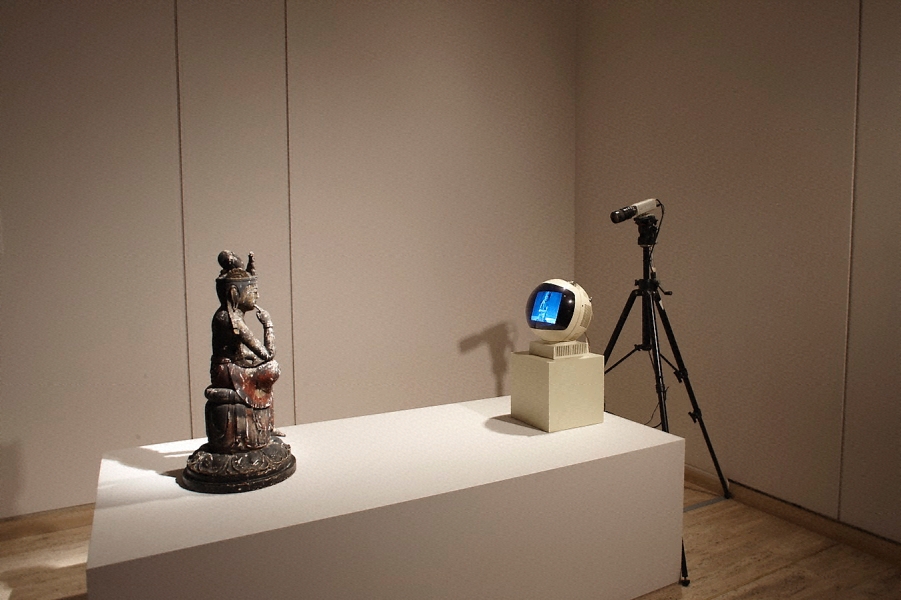Who is the practitioner (what is their name?) and when were they practicing?
Photographer Henri Cartier-Bresson (1908 – 2004), Began a life-long passion for photography in 1932 after spending a year in the Ivory Coast, where he discovered the Leica camera. Although labelled a photo-journalist, Cartier-Bresson considered himself as a surrealist artist. It is said that he would search for a visually stimulating area that would create a good composition and wait for his ‘decisive moment’ to occur (The New York Times, 2016).
What is the title of the photo or video you have chosen to analyse (can you provide a link?)
Title: Palermo (Boy with Wheel)
Where: Palermo, Sicily, Italy
When: 1971

With the photo or video, you are examining when was it produced (date)?
The photo was taken in Palermo, Italy in 1971
How was the photo or video authored?
This photo was taken on black and white, 35mm film using an analogue camera. Cartier-Bresson was known for his exclusive use of Leica camera’s and his candid photography which became known as “The Decisive Moment”, the same name of his first book published in 1952. “The Decisive Moment” is the singular moment in which the photographer has the opportunity to capture a photograph that accurately reflects the time, place and culture, a skill he learnt from hunting. (Zanon & Sabbag, 2017)
“For me the camera is a sketch book, an instrument of intuition and spontaneity, the master of the instant which, in visual terms, questions and decides simultaneously. It is by economy of means that one arrives at simplicity of expression.” -Cartier-Bresson
This photo is an example of his dedication to ‘the decisive moment’. It is shot on a diagonal angle with two little boys playing with a bicycle wheel and a stick on the footpath in the foreground. In the background we see a street full of traffic dominated by a large black hearse. This photo, in my opinion, is the epitome of the decisive moment and Cartier-Bresson’s expression “the camera is a sketch book”. This photo represents the balance between life and death. The juxtaposition of the youthful boys, full of life and energy. Opposed to the hearse, a symbol of death and a staple at funerals, stuck in traffic going no where. Both moving in opposite directions unaware of each other further implying the juxtaposition. Even the small Italian economy cars in the background are bright cheerful colours when compared to the hearse, implying contentness in the current situation, almost as if they are saying “It’s not great being stuck in traffic, but at least I’m not in a hearse.”
All that you can draw from this image makes it more than just a photo (again, in my opinion). It’s like a painting by a revered artist that has come to life. A photo that captured a decisive, powerful moment.
How was the photo or video published?
Due to the photo being taken with a film camera, It would’ve been developed, which Cartier-Bresson apparently didn’t like, even opposing enhancements and edits to images after they were taken, which detracts from the decisive moment that photo was taken. According to Christie’s (2019) although taken in 1971, it wasn’t published until 1990. Analogue cameras capture photos when the shutter opens for a split second, allowing light to pass through the lens, which is reflected onto film which is a light sensitive plastic. This film is developed in a dark room, which is lit with red light so that you can see what you’re doing without destroying the film. In the dark room, the film moves through a series of chemicals from developer, to stop bath and then fixer. This creates a film negative, which can have light shined through it in order to cast the photo onto light sensitive paper which creates a positive print. Due the technology surrounding analogue cameras, this method of publishing greatly differs from how we publish photos now (Woodford, 2018).
How was the photo or video distributed?
Although I can’t find any information on ways this photo was distributed, due to the technology and typical methods of distribution at the time, the photo would’ve been distributed through print media. It is most likely that it would have been shown at one of Cartier-Bresson’s many exhibitions he held all around the world from 1933 – 2006, or one of his many books published between 1952 – 2006. Exhibitions, books and other print media would have been the only way to one of his photos back then. However now, with the internet, replicas and copies of this photo and others can circulate online through sites like Pinterest, tumblr, Artnet, Google Images and Instagram as well as his own photography cooperative Magnum Photos, which he co-founded in 1947. The circulation of Cartier-Bresson’s images allows for a re-distribution to happen, exposing his work to a new generaion.
References:
https://www.magnumphotos.com/photographer/henri-cartier-bresson/
https://en.wikipedia.org/wiki/Henri_Cartier-Bresson#Photography
Zanon, W.R & Sabbag D.M.A 2017, ‘Henri Cartier Bresson’s Decisive Instante and Indexation: An Exploratory Study of Photography and INdexing Methods’, Digital Journal of Library and Information Science, vol.15(3), pp.639-714.
The New York Times 2016, ‘Henri Cartier-Bresson, Whose “Decisive Moment” Shaped Modern Photography’, The New York Times, 3 August, viewed 5 April 2019, <https://www.nytimes.com/interactive/projects/cp/obituaries/archives/henri-cartier-bresson-photography>
Woodford, C 2018, Film Cameras and 35mm Photography, Explain That Stuff, viewed 5 April 2019,<https://www.explainthatstuff.com/how-film-cameras-work.html>
Christie’s 2019, 100 photographies provenant de la Fondation Henri Cartier-Bresson, Christie’s, viewed 5 April 2019, <https://www.christies.com/lotfinder/Lot/henri-cartier-bresson-1908-2004-palerme-italie-1971-5494214-details.aspx>


